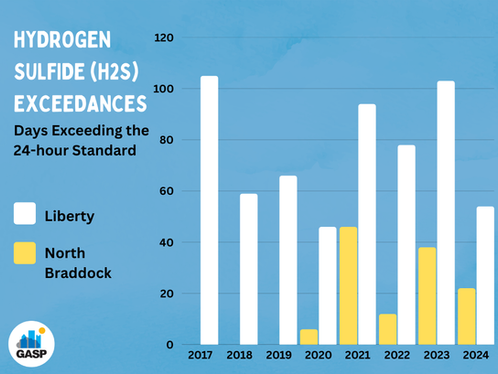An All-Too-Familiar Stench:
GASP Guide to Hydrogen Sulfide (H2S) & That Rotten-Egg Odor
What is hydrogen sulfide and why do we care?
Hydrogen Sulfide, or H2S, is a toxic gas that occurs both naturally (from sources such as swamps, manure pits, and oil, gas, and water wells) and as a result of industrial activity (including, most notably for our region, coke making).
According to the Agency for Toxic Substances and Disease Registry, H2S is a colorless gas recognizable by its rotten-egg odor. Exposure to the levels of hydrogen sulfide we see in the Mon Valley can cause:
● irritation to the eyes, nose, or throat
● headaches
● poor memory
● tiredness
● breathing problems for some people with asthma
● balance problems
.png)
In 1971, Pennsylvania adopted ambient air quality standards for H2S. Under those standards, H2S concentrations in the ambient air may not exceed 5 parts per billion (averaged over any 24-hour period) or 1 part per million (averaged over any one-hour period). Those standards have been incorporated into the Allegheny County Health Department's air pollution rules and regulations.
According to a recent 31-page study conducted by the Allegheny County Health Department, several years’ worth of H2S exceedances in the Mon Valley “can be attributed entirely to emissions from U.S. Steel’s Clairton coking facility.”
Despite U.S. Steel scapegoating landfill facilities, we want to point out that the study also stated: “ACHD did not identify evidence of any other source contributing to the exceedances.”
In March 2023 the Allegheny County Health Department announced it launched a new dashboard dedicated to tracking hydrogen sulfide - a move that came in the wake of repeated calls from GASP for ACHD to better communicate issues related to the air pollutant prominent in the Mon Valley.
The dashboard displays up-to-date information from the county’s two H2S monitoring sites located in North Braddock and Liberty. While hourly H2S readings have been available on the department’s website for years, creating the dashboard allows for the data to be understood in a more straightforward and discernible way.
The Allegheny County H2S Dashboard is available on the county’s website and is embedded below.
If US Steel’s Clairton Coke Works is clearly the main source, are they being held accountable and taking steps to stop exceeding the H2S standard?
U.S. Steel was issued a notice of violation regarding H2S exceedances on April 1, 2021. In it, ACHD required the company to set up a meeting with the Air Quality Program to discuss the issue.
Then, on March 7, 2022, ACHD issued an enforcement action with a $1.8 million civil penalty for H2S exceedances that occurred at the Liberty monitor. In that order, the Air Quality Program noted: “Following the issuance of the Notice of Violation on April 1, 2021, U.S. Steel did not take any corrective actions to try to minimize or stop the exceedances of the H2S standard caused by the Clairton Coke Plant.”
In the latest enforcement action issued Dec. 29, 2023, ACHD assessed a $2.2 million civil penalty AND ordered U. S. Steel to “take action to prevent future exceedances of the H2S ambient air concentration standard from occurring and provide ACHD with a plan to achieve and maintain compliance with its requirement to not cause exceedances of the H2S ambient air concentration standard.”
The Air Quality Program put the company on notice about these exceedances more than three years ago, and $4 million in associated fines have been assessed since 2022. Despite these actions, the Mon Valley is still dealing with burgeoning exceedances and days-long periods of stench.
What are the major concerns related to H2S now (in 2024)?
From 2017 to 2024, annual exceedances of Pennsylvania’s 24-hour average standard for H2S has ranged from 46 to 105 days. We would like to see that number at zero in the coming years. Sometimes the exceedances take place over consecutive days, meaning consistently high levels for around a week is not uncommon.
“It’s not just the number of exceedances that we have been experiencing that concern us,” GASP Executive Director Patrick Campbell said. “So do the spikes recorded at the Liberty monitor and the fact that this issue persists despite millions of dollars in assessed fines against U.S. Steel over the past few years for such exceedances - as well as mandates that the company craft an action plan to address them.”
GASP attended the May 8, 2024 Board of Health meeting to again draw attention to the ongoing H2S issue. Find an overview and Patrick’s full comment here. Several community members and representatives of partner organizations also attended and delivered in-person and written comments.
What’s next?
These exceedances and prolonged episodes of stench beg the question: What updates and/or operational changes have been made at U.S. Steel’s Clairton Coke Works and what is ACHD doing to ensure the company is taking appropriate action to stem this issue?
Because Allegheny County residents have been met with silence on this issue while continuing to not only suffer, but wonder what progress has been made - what actions are being taken to protect our public health and quality of life.
What can you do if you smell H2S?
If you think you smell a rotten egg-like odor linked with H2S, report it to the Health Department through the Self-Service Portal. Making a report is quick and direct - it’s important to demonstrate that people are paying attention and are concerned about the issue. We have more information about making an air quality complaint here.



















